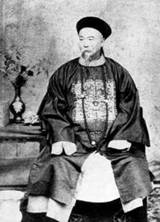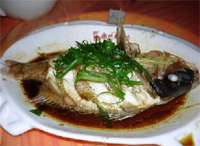When you come to Hefei, the Luzhou Roast Duck must be the first recommended cuisine by the local tour guide. Luzhou Roast Duck originally was served to the royal court as the imperial dish. Until the period of Ming Dynasty (1368-1644), this cuisine could be found being cooked by local families.
You will be attracted by the duck's golden yellow shininess, crisp skin and tender meat. Compared to Beijing Roast Duck, it has moderate fat and salt, rich taste, and plenty nutrients.
In 1987 it was awarded to be the excellent food by Anhui province and commercial ministry. In 1983, it got the gold medal of the first session China Food Expo.
2. Li Hongzhang Hodgepodge
It’s a popular dish named after Li Hongzhang (1823-1901), a top official of the late Qing Dynasty (1644-1911) from Anhui province, who made strenuous efforts to modernize the country that ended in several major rebellions. He became a leading figure in China's relations with the Western powers.

Li Hongzhang
It is said that when Li Hongzhang visited the United States, he invited some American friends to have dinner. After the entrée, Li mixed together all the ingredients he had left over and cooked up a new dish. All his guests praised the delicious concoction, and asked Li for its name. Li told them, in his distinctive Hefei dialect, that the dish was called "Zasui,” or “hodgepodge” in English. From then on, the dish was known as "Zasui,” or “Li Hongzhang Hodgepodge,” and became popular in both the U.S. and China. Its main ingredients include sea cucumber, fish maw, squid, bamboo shoots, dried beans, chicken, ham, egg yolk pudding, and pigeon eggs, liver and so on.
Cao Cao Chicken is also called Xiaoyao Chicken, and it is a famous local dish of Hefei.
It is said that Cao Cao as the General of Wei Kingdom stationed the army in Xiaoyaojin of Hefei. He was extremely busy with the military and political affairs that he was overtired and caught the illness. During the treatment, the kitcheners followed the words of doctors to add the Chinese traditional medicine into the chicken and made this chicken to be a medicine. Afterwards, Cao Cao gradually became better and often needed to eat this kind of chicken, so people called this chicken Cao Cao Chicken.
4. Lord Bao Fish (or Bao Gong Fish)
Lord Bao Fish is another well-known Hefei dish. This fish was originally found in a moat called Lord Bao River; hence it got the name Lord Bao Fish. This cuisine is a traditional cold dish - tender meat and dark reddish crisp skin.
In 1958, when Chairman Mao Zengdong visited Anhui province, the famous kitchener Liang Yugang specially cooked this dish and was highly praised by Chairman Mao.










